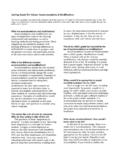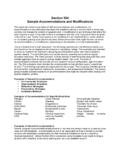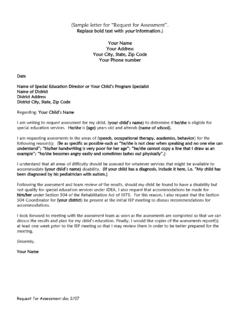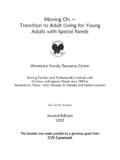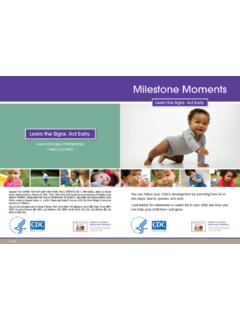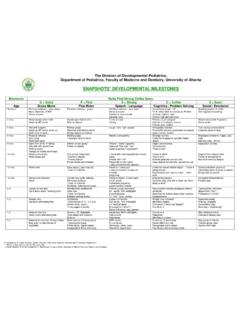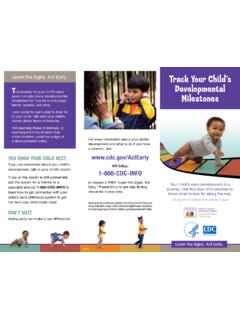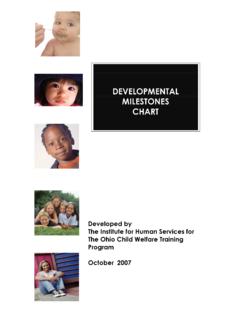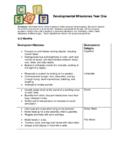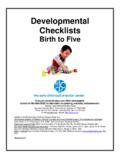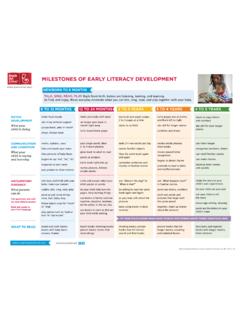Transcription of The premature infant: How old is my baby?
1 WarmLine FRC premature developmental Milestones 9-8-14 The premature infant : how old is my baby? Babies who are born prematurely often have two ages : Chronological age is the age of the baby from the day of birth the number of days, weeks or years old the baby is. Adjusted age is the age of the baby based on his due date. Health care providers may use this age when they evaluate the baby s growth and development. So, if a baby is 6 months old, but was born two months early, his adjusted age is 4 months. Calculating your baby s adjusted age: Example: Chronological age: 20 weeks The number of weeks your baby was premature : 6 weeks Subtract the number of weeks premature from the chronological age (this is your baby s adjusted age): 20 weeks - 6 weeks = 14 weeks.
2 Divide your baby s adjusted age in weeks by 4 to determine your baby s adjusted age in months: 14 4 = months. What to say when someone asks: This is up to you. You can say: He s 6 months old, but he was born two months early, that s why he looks like a 4 month old. OR He s 6 months old and leave it at that. Remember: When people ask about your baby, they usually are being kind, not nosy. Catching up: Most premature babies catch up developmentally, in two to three years.
3 After that, any differences in size or development are most likely due to individual differences, rather than to premature birth. Some very small babies take longer to catch up. You can stop adjusting your baby s age when it feels most comfortable to you. March of Dimes August 2009 WarmLine FRC premature developmental Milestones 9-8-14 Overview of Typical Premie developmental Milestones By understanding the common ages and stages of child development, you can monitor your preemie s progress and identify the first signs of problems. It is important that developmental delays, even slight ones, are not overlooked. Some children with delays skip steps in learning (they will learn A, then C, and skip B). These gaps in learning may or may not affect later learning, but should be assessed.
4 Think of your child s early learning development like building a house a solid foundation is essential. Use the following chart as a guide for monitoring your child s development and dis-cuss any concerns with your pediatrician or developmental specialist. (From Primary Care of the Preterm infant ) Age Gross Motor Fine Motor Cognitive (Thinking) Communication Social 1 month adjusted age Lifts head for a few sec-onds when lying on stom-ach. Hands usually fisted with random opening and closing; brings hands to mouth; stares at objects and lights. Begins to handle different sensory inputs (however, most movement is random and a reflex to the envi-ronment. Cries to make needs known; listens and soothes to voice; makes eye contact. Regards face; enjoys being talked to and held. 3 months adjusted age Fairly good head control on tummy and in sup-ported position; lifts head and chest when lying on stomach; thrust arms and legs in play with both sides appearing the same.)
5 Holds on to a rattle; follows slow-moving objects with eyes; brings hands together at mid-chest area. Begins to realize body movements affect sur-roundings (bats at mobile, bounces in an infant seat); begins the effort to repeat movements that create a response. Coos and laughs; has different cries for differ-ent needs (hungry, hurt, bored). Smiles easily and spontaneously. 6 months adjusted age Rolls and is beginning to sit well without support; supports self on one forearm while lying on side; pulls forward with arms while lying on stom-ach. Reaches and grasps with both hands; moves toys from hand to hand. Shakes rattle; starts to imi-tate gestures that self can see and engage in (smiling and frowning), has an in-creased interest in sur-roundings and the result of actions. Babbles, laughs, coos; turns to look at new sounds.
6 Awareness of strangers; smiles at self in mirror. 9 months adjusted age Gets into and out of sit-ting position on all fours independently; crawls on hands and knees. Points with index finger. Takes toys in and out of containers. Begins to use 2 syllable sounds together ( ma-ma , dada ) Anxious response to strangers; strong attachment to par-ents. WarmLine FRC premature developmental Milestones 9-8-14 Age Gross Motor Fine Motor Cognitive (Thinking) Communication Social 12 months adjusted age Walks alone (may take up to 15 months) Uses thumb and pointer fin-ger to grasp small finger foods; drops objects into a small container. Begins to use objects for specific functions (comb to comb hair); begins to an-ticipate behavior will have a consequence. Says at least 2 words in addition to mama and dada ; recognizes own name, imitates familiar words.
7 Shy, but enjoys at-tention and play; gives affection and cuddles. 18 months adjusted age Walks up steps while holding on to support; runs Builds tower with 3-4 blocks Begins trial and error thinking; begins to under-stand reasoning Points to three basic body parts; follow sim-ple requests; knows and names 2-5 familiar ob-jects; combines 2 words ( all gone , bye-bye ). Helps with simple tasks, imitates oth-ers actions sponta-neously. 24 months adjusted age Alternates feet while go-ing up stairs; kicks ball. Stacks 6 cubes; turns individ-ual book pages. Matches circle, square, triangle; understands the use of many objects; un-derstands self is separate from environment. Uses 2-word phrases; understands simple questions and com-mands; asks for a drink. Washes and dries hands; helps get dressed.
8 30 months adjusted age Jumps with both feet. Strings beads; holds pencil in hand, not fist. Knows simple songs with hand gestures; completes simple puzzles; begins to understand basic instruc-tions. Uses pronouns, I , you , and me correct-ly; states full name, may say no when means yes . Plays tag; asserts personality. 36 months adjusted age Balances on one foot for 5 seconds; rides tricycle. Imitates building a block bridge. Knows big and little; un-derstands basic instruc-tions; believes all objects are related to her some-how. Can match primary col-ors; can sing songs; asks what questions. Plays with children; takes turns with hand gestures. WarmLine FRC premature developmental Milestones 9-8-14 Warning Signs Consult your pediatrician or developmental specialist if your child exhibits any of the signs listed below at the ages indicated.
9 At 6 months adjusted age: Difficulty lifting her hand and pushing up on her arms while lying on her stomach; Cannot stay lying on her side to play with toys; Is not sitting, even with support; Is not rolling or is rolling by arching her neck and back ; Makes no effort to reach or bat at objects; Does not move her head toward a sound or search for objects with her eyes; Grasps an object weakly or holds only for a moment; Keeps her hands fisted and/or keeps her thumb inside her fist; Is not able to get her hands to her mouth or together; Continues to have trouble taking a bottle or first solids; Does not coo or babble. At 12 months adjusted age: Is sitting but not able to sit independently; Is crawling or bunny hopping by moving both legs forward at the same time; Is not easily able to pick up small objects, such as finger foods; Does not search for a hidden object; Does not vocalize consonant and vowel combinations ( ba ); Does not look at books for short periods of time.
10 (Keep in mind that if she is busy learning to crawl and walk, she may not have much interest in sitting down activities. Encourage her to spend some time doing quiet activities, such as looking at books); Does not respond to simple familiar speech routines, such as pat-a-cake; Uses one side of her body much more often than the other. At 18 months adjusted age: Does not walk, or constantly walks on her toes; Does not imitate sounds or produce any sound combinations that represent a word ( doodie for cookie ) Cannot build a town with blocks Is most interested in putting toys in her mouth during play, rather than more purposeful play using her hands; WarmLine FRC premature developmental Milestones 9-8-14 Understands fewer than eight words. At 24 months adjusted age: Does not put two words together in speech; Does not identify basic objects or pictures of basic objects ( ball ); Has large motor skills that are lacking in balance and control (falls or trips a lot more than other children her age); Cannot complete a simple puzzle or shape sorter; Does not follow simple commands, such as give me ; Cannot identify basic body parts.
